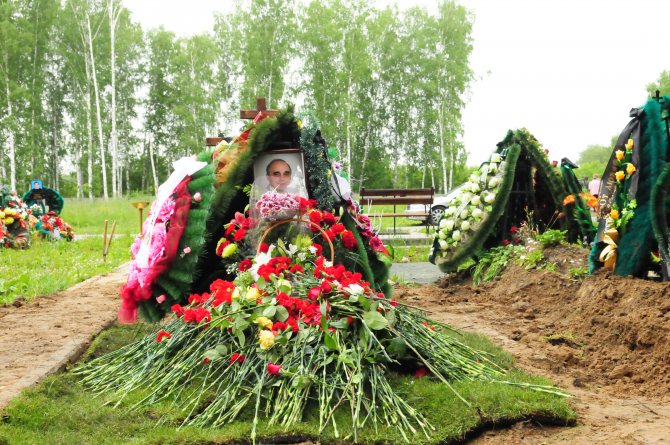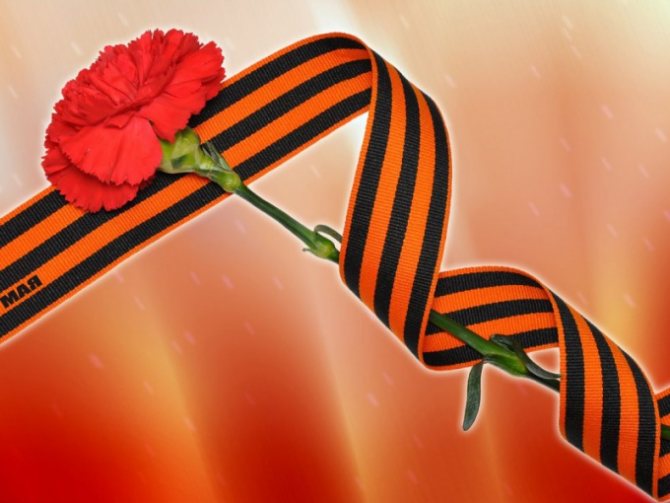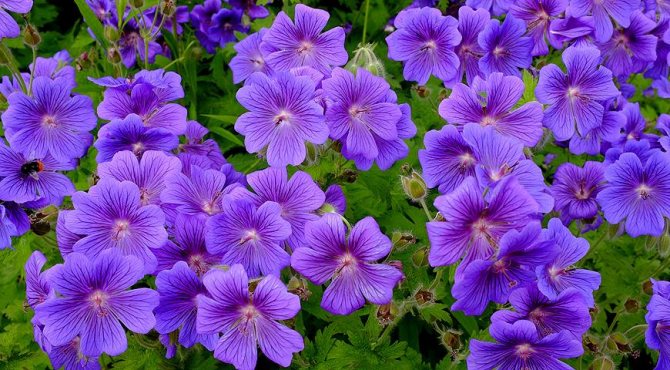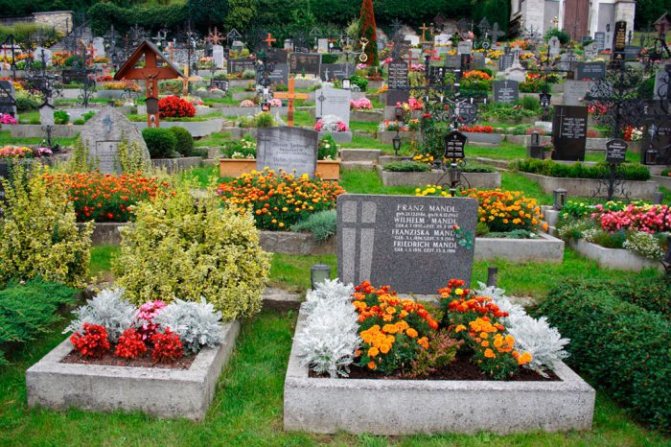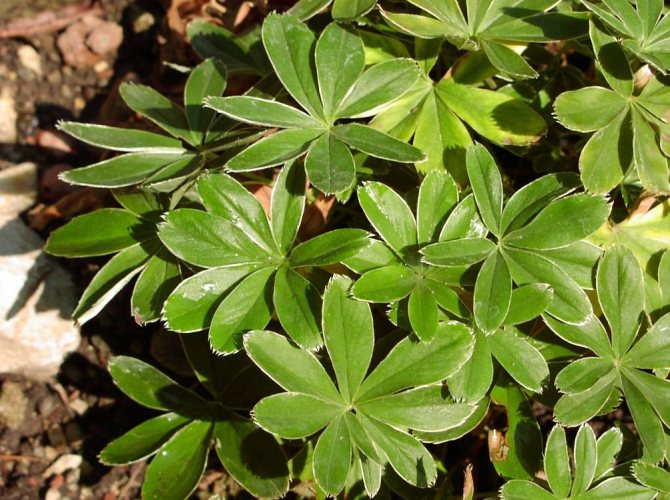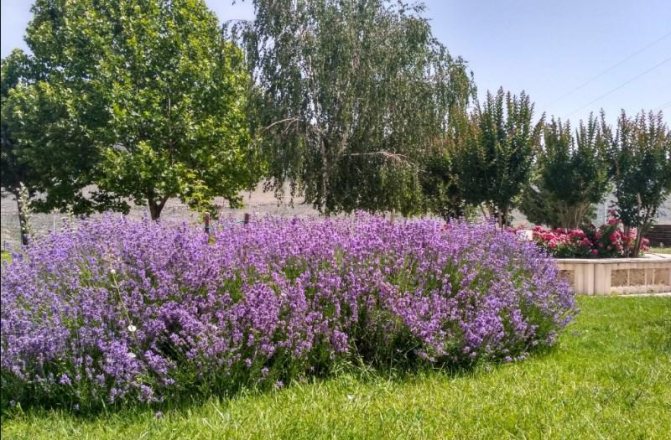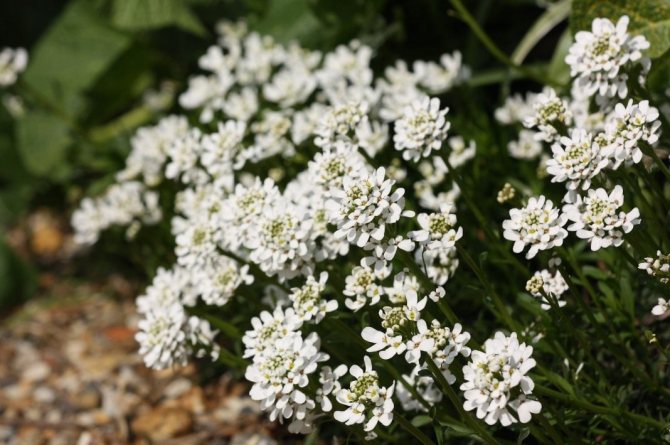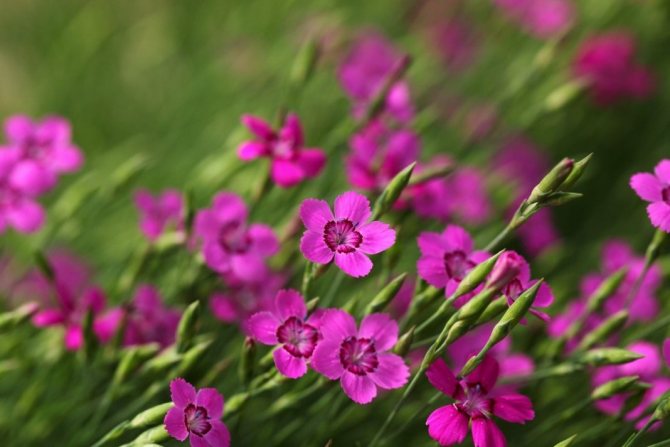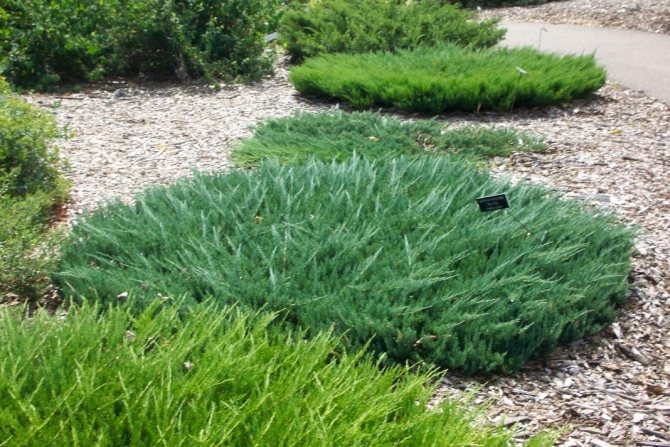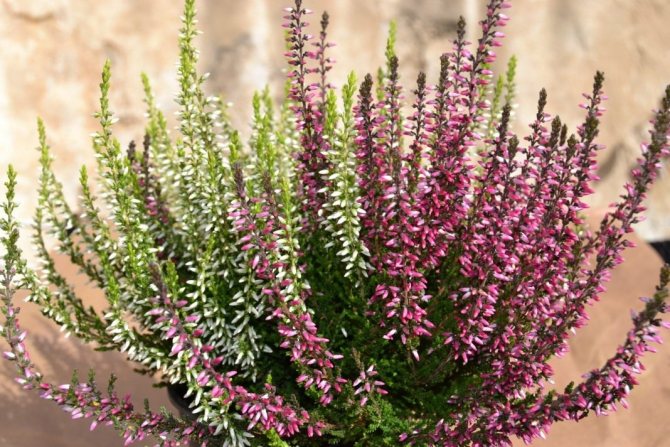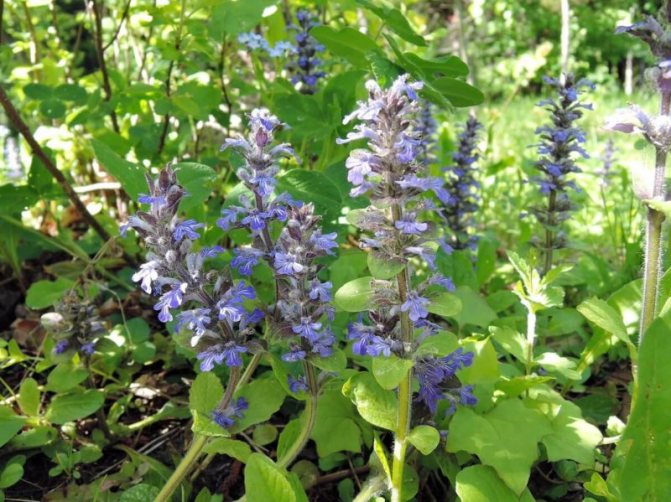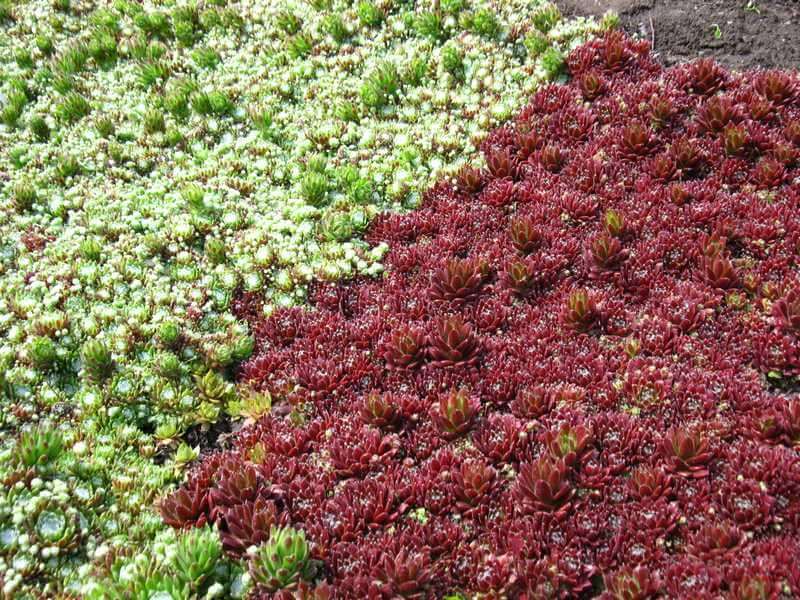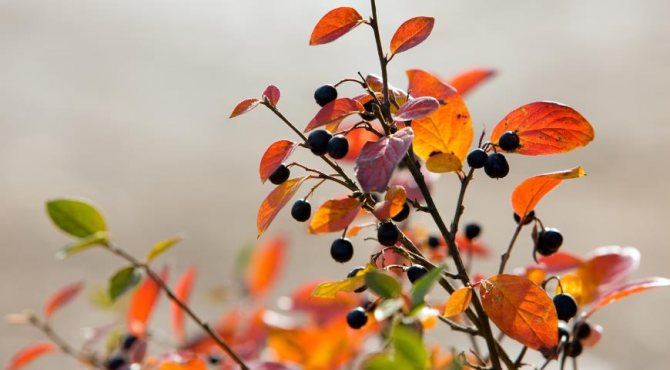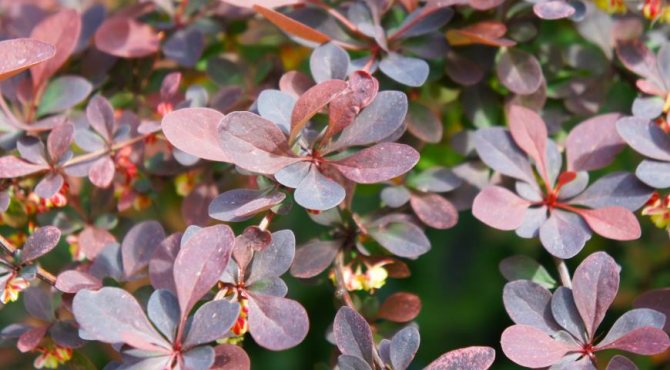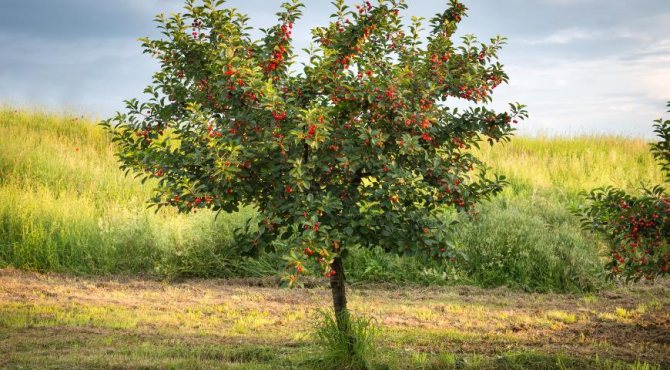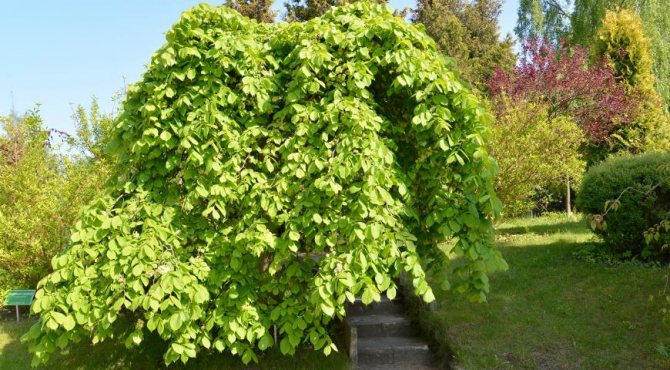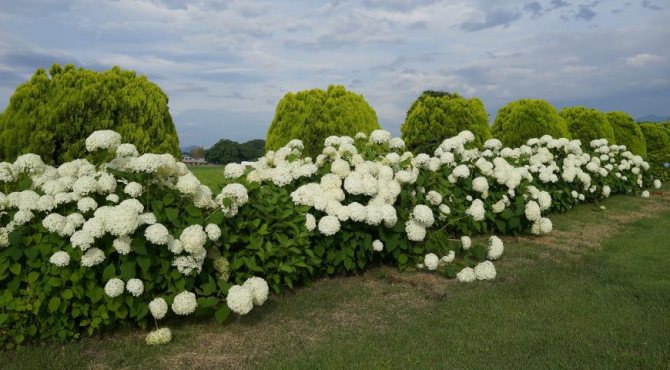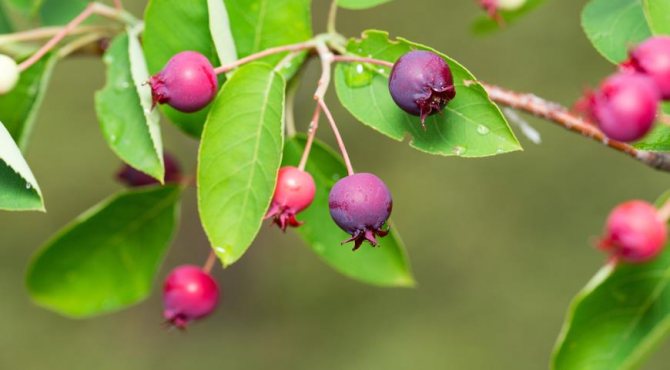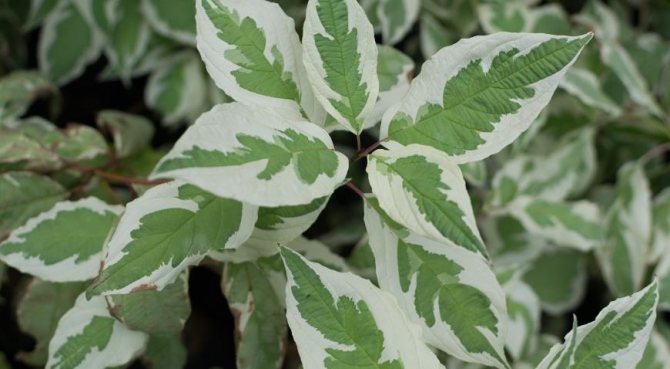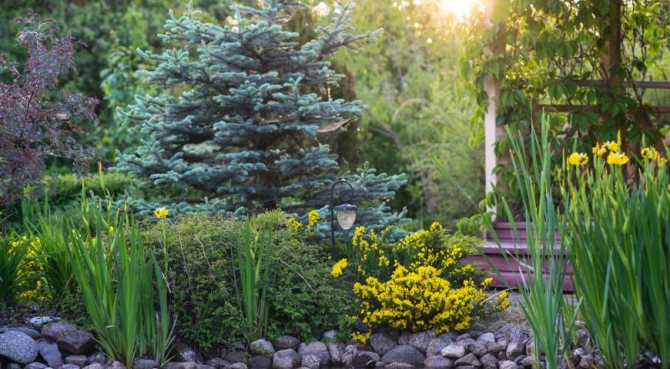Artificial flowers for cemetery
I'll start with the main thing - with the question that I am asked from time to time: "Why are artificial flowers being worn in the cemetery?" Guys, I don't know why people do it, why it has taken root in our culture.
Take a look at our traditions - flowers were always brought to the graves either live, freshly cut, or they took dry bouquets. It can be assumed that from the custom of bringing dried flowers, the idea was once born to make them from something more durable.
Now on sale you can find a lot of options for bouquets and wreaths of artificial flowers for a cemetery: plastic, forged, stone flowers, as well as made of foamiran, fabric and other material.
People willingly buy a variety of artificial flower arrangements in the cemetery, as they consider it beautiful, durable and does not require any maintenance. I bought it, installed it and you can forget it for the next year.
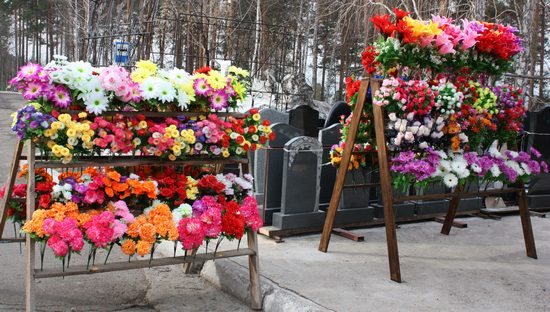
I do not take artificial flowers to the cemetery, as I am sure that they are of no value to the deceased. The artificial is neutral - it is not alive, has never lived and cannot die; there is no life or death energy in these compositions, they are neutral. The dead perceive it in the same way - neutrally, in no way. They are neither warm nor cold from such gifts, they do not give them anything.
Artificial flowers are carried to the cemetery as decorations for themselves. I bought it myself, I decorated the grave myself, and I like it, it is beautiful to me, and most importantly - practical, because even after a couple of months it will look as if I was here only yesterday.
If you buy artificial flowers in a cemetery just to give yourself a credit, then keep doing it. If you sincerely want to please your deceased relative or friend, then you should not bring him artificial flowers to the cemetery.
Wreaths and vases
The funeral wreath is an important part of the funeral procession. Wreaths are carried in front of the coffin, and also laid at the grave. Usually, wreaths are given from loved ones, from a group of friends, a team or associates for a certain job.
Artificial flowers are more often used in wreaths than natural ones. But you can also use them. An artificial wreath will stand for a long time, without losing either shape or color. Often a photo of the deceased and a mourning ribbon are attached to the wreath. Usually this is black material, with a signature from whom it was brought, for example, from colleagues, from friends, and so on. The wreaths are the main color of the composition. Usually they are made of dark green, like a Christmas tree, and the plastic plants themselves are painted in mourning colors, which we talked about above.
Often, as part of the improvement of the grave, a special funeral vase is installed on the site. Then the brought plants can be planted there, and not put on the grave. It is worth making sure that there is enough water there, especially if you are in a hot climate.
You can see wreaths and funeral vases on our website in the "Ritual goods" section. We work in Minsk, and for all questions you can contact us by phone numbers listed on the website.
What flowers are worn in the cemetery
According to tradition, fresh flowers are brought to the cemetery. A living flower is cut, given to the dead, and the flower dies on his grave. The dead receive the life energy of this flower.
It is believed that the flower dies in our world and appears in the world of the dead. Exactly the same as the dead, who has already made this transition. The dead with the flower presented to him receives the energy of his life, and the energy of his death.
When choosing flowers for a cemetery, you can focus on different principles:
- those that a person loved during his lifetime;
- those that are customary to bring to the cemetery;
- those that are profitable to give.
Each of these principles is true in its own way. If they choose flowers in the cemetery that a person loved during his lifetime, this shows the deceased that they remember him, remember his preferences.
Flowers that are profitable to give to the deceased will be chosen by the sorcerers working in the cemetery. To achieve certain goals, the sorcerer negotiates with the dead to do a certain job. Therefore, the sorcerer will give the dead the things that he needs to do his job. Sometimes flowers are required - the sorcerer knows what and how many flowers to bring to the cemetery.
Now about the flowers that are brought to the cemetery according to tradition. These are carnations, roses, calla lilies, lilies, less often - other types of flowers. Whichever flowers you choose in the cemetery, always take only a fresh flower in full bloom.


Do not take unblown buds to the cemetery!
A cut, unopened bud symbolizes a baby who died before birth, and according to the magical law of similarity, it can realize a similar situation.
This is not understandable to the layman, but knowledgeable people strictly follow this rule, picking off all the buds from the bouquet intended for the dead. This is done so that the dead understand you correctly.
Color also has a certain symbolic meaning, which the dead understands without words:
- yellow flowers for the cemetery symbolize parting;
- white flowers - protection;
- red - passion;
- pink - tenderness.
Flowering ground cover plants
Creeping flowers are great for planting in a cemetery. Such plants create a dense cover that gives a decorative look to burials. Ground cover flowers prevent weeds from germinating.
Periwinkle
The plant can grow in any soil. During the season, periwinkle grows by 7 square meters.This culture can be planted in the shade and in the sun.
- withstands prolonged frosts (leaves with green leaves under the snow);
- does not need special care;
- tolerates drought;
- flowers are colored blue, red, white, lavender;
- propagated by seeds and dividing the bush.
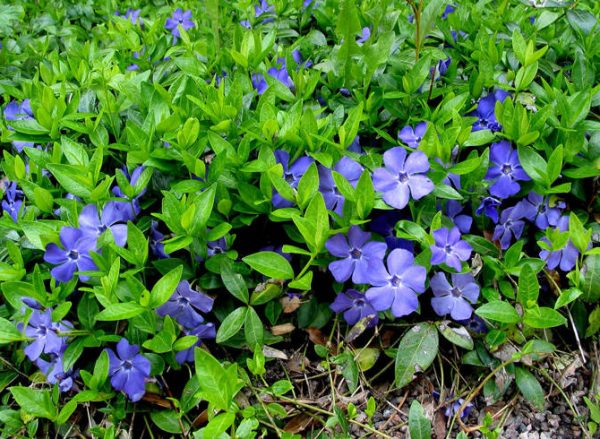

Periwinkle
Sedum "White Moss"
Perennial plant up to 10 cm high. Creeping shoots with dense foliage. Flowering begins in July and continues until frost. Flowers can be white or pink.
The plant thrives on rocky soil, in the shade and in the sun. Sedum propagates well by seeds or cuttings.
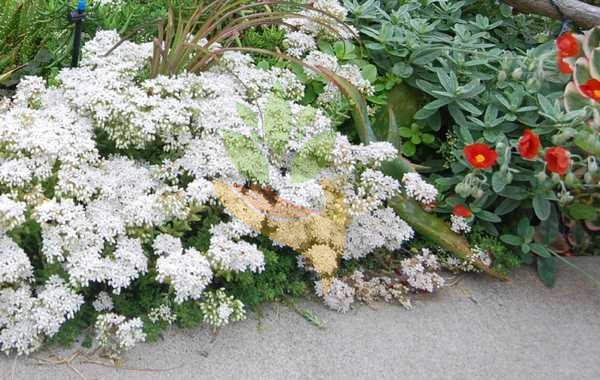

Sedum "White Moss"
In addition to this species, the following varieties of sedum can be planted in the cemetery:
- Kamchatka species, variety "Golden Carpet". The flowers are yellow, the first buds appear in July. The root system is lignified, so the plant is not afraid of frost;
- false species, varieties "Raspberry" and "Kokeinum". These sedum varieties form a purple carpet. Plants prefer sunny areas, but can grow in the shade. They endure frosty winters;
- bent sedum, Blue Forest grade. Forms a carpet up to 15 cm high, blooms in the third year after planting. From August to September, bright yellow flowers appear on the plants.
Phlox subulate
This plant prefers sunny places, but can grow in the shade without prejudice to flowering. Phlox can grow on any soil. Tolerates drought and low temperatures. For planting in a cemetery, varieties are used that do not exceed a height of 25 cm.
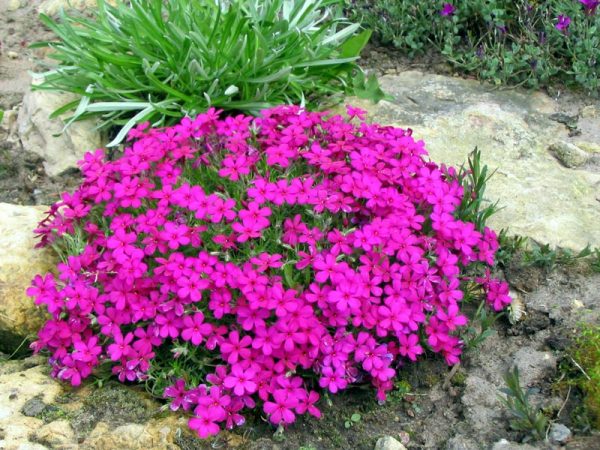

Phlox subulate
- "Candy Strips" - plant height 15 cm, white flowers with a red border. Blooms until the end of August in favorable weather, possibly re-blooming in autumn;
- "Esmerald Blue" - flowers of a heavenly purple hue, plant height about 15 cm;
- "Pearl Beauty" - this variety grows rapidly, flowers are purple in color. The first buds appear in early May.
- "Main" - this variety has small flowers of a snow-white shade, plant height 10 cm.
What flowers should a woman bring to the cemetery
Traditionally, roses are brought to the cemetery for women. Roses symbolize emotions. If you passionately loved a woman during your lifetime, bring her red flowers to the cemetery. If you have tender feelings, take a pink bouquet. If neither, buy yellow or white flowers.
You can focus on a person's personal preferences during life - give what you liked. If a woman loved wildflowers, collect a bouquet for her in the field before going to the cemetery - she will be pleased.
You can bring a bouquet of dried wildflowers if you go to the cemetery outside of their flowering season. Think about it ahead of time, collect the wildflowers when they bloom, dry them and save them.
Made by human hands
What flowers should be placed on the grave
? For deceased relatives and friends, you can choose wreaths that are decorated with ribbons and buds, artificial Christmas tree branches, flowers. But take into account that on the date of birth, the anniversary of the death of the deceased, it is not worth bringing such wreaths to the cemetery, since this is not customary in our country.
The main advantage of these colors is their long service life. They allow you to decorate tombstones in the cold seasons of the year and do not lose their appearance for a long time. The main advice in this case is that the bouquet looks rather restrained. To do this, it is advisable to buy compositions that have restrained colors, for example, purple and dark red are ideal. Modern acidic, bright flowers in the atmosphere of a cemetery will look defiant, flashy, which is unacceptable.
Flowers in the cemetery for the anniversary and 40 days
Flowers in the cemetery for an anniversary or 40 days are chosen more solemnly. White lilies are very good for such cases - they symbolize death, purity, holiness. Previously, white lilies were given only at really important moments in a person's life. They were brought on the birthday of the baby, on the wedding day for the newlyweds and at the funeral.
Also, the most suitable flowers in the cemetery for the anniversary would be a bouquet of white calla lilies. These flowers are also considered the flowers of death and are readily accepted as dead.
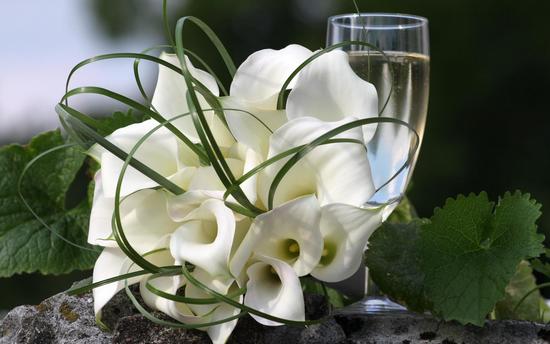

It is good to bring a basket of fresh flowers or a wreath of fresh flowers to the cemetery for 40 days or an anniversary. Do not carry artificial flowers to the cemetery.
General selection rules
The first thing to understand is that funeral flowers should not be flashy and bright. Since this procedure is solemn and not the most fun, the flowers must fully comply with it. That is, to be a neutral, modest shade, not to be conspicuous, to look neat and restrained.
You should not choose bouquets that include two or more different shades of color. Especially if these shades are variegated. Such luridness is completely inappropriate in a solemn sad ceremony.
Give preference to colors of calm, dark shades. In this case, it is necessary to take into account the age, gender and other characteristics of the deceased.
If flowers are placed in a coffin, they must be removed from the cellophane wrapper.
In the absence of the opportunity to personally attend the funeral, it is appropriate to send a basket of flowers or a bouquet with a card, where condolences are expressed in writing.
How many flowers are worn in the cemetery and why
Sometimes they ask how many flowers are brought to the cemetery. The question of how many flowers it is customary to wear in a cemetery is decided according to the traditions of a particular country or culture.
In our cemetery, it is customary to wear an even number of flowers, since our ancestors saw the symbolism of death, peace, completeness in even numbers. An odd number of flowers are given to us alive.
How many flowers will you bring to the cemetery - it depends on your desires and capabilities. It can be just two flowers, or it can be a large bouquet of 50 flowers - whatever you want.
I must say that sorcerers sometimes carry 9 or 13 flowers to the cemetery - this is due to the symbolism and conditions of certain rituals.
Man
If the deceased is a man, it is appropriate in this case to use bouquets of contrasting shades. The asymmetrical arrangement of the elements of the bouquet will pay tribute to the decisive and courageous character of the deceased.
It is better to choose flowers in cold tones. From a warm palette, red will do. However, it should be understood that scarlet flowers will be appropriate only if the deceased was a father, husband or loved one.
You should not choose pink flowers for a man: whatever one may say, this is the least suitable shade in this case. In addition, it is undesirable to give preference to flowers with a delicate aroma: such smells are not at all associated with masculinity.
If the deceased was engaged in spiritual practices, a bouquet of violets and lilies would be an appropriate choice. It would be nice to plant a cypress near the grave - a symbol of wisdom and spiritual purity.
Flowers for Muslim cemeteries
If you are wondering how to choose flowers for Muslim cemeteries and how many flowers to bring, you need to know the following.
Muslims have their own customs and their own special attitude towards the dead, which is dictated by the rules of the Koran. In traditional Muslim cemeteries, you will not see the usual monuments with a photograph of the deceased.
You will see modest graves equipped with only a stone slab. The name of the buried person, dates of birth and death and lines from the Koran are written on the plate.
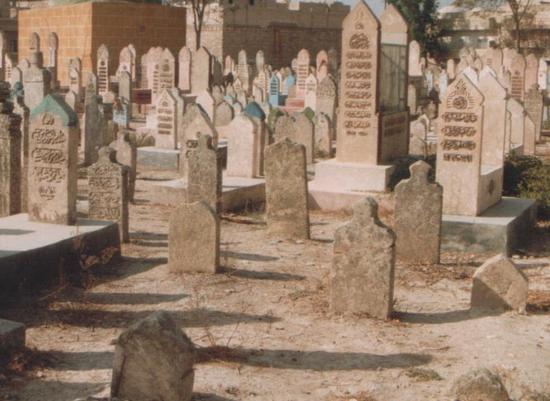

The Prophet advised avoiding spending money on the dead and considered it more correct to care for the living than for the dead. Therefore, it is not accepted to bring candles, bouquets, wreaths, artificial or natural flowers for Muslim cemeteries.
If the deceased Muslim and his family strictly adhere to the customs of their religion, then you should not carry flowers to his grave.
However, I often see the graves of Muslims that are not decorated according to the rules of the Koran. I often see the graves of Muslims, located among the graves of the “infidels”, with a monument and a photograph of the deceased, flowers are on it.
In order not to be mistaken, ask the living relatives of the person to whom you wish to come to the grave, whether you should bring flowers to the Muslim cemetery.
Funeral bouquets
Let's make two important notes right away: you shouldn't bring lush bouquets to the funeral, the number of plants in which exceeds 12. A modest couple will be much more appropriate. The arrangement of the bouquet should also not be pretentious. Moreover, often at the funeral, the brought bouquets are disassembled and laid out in the grave.
The second is the color scheme. It is necessary to do without bright bouquets of yellow, cream, pink and orange shades. Dark tones, blue, deep purple, red, burgundy will be more appropriate here. White is fine too.
How many flowers to carry to the grave? Paired quantity, not more than 12. The traditional option is considered to be 2 flowers. This mystical number is connected for a reason. There are many legends. One of them: one flower is given to a deceased loved one, the second to God or a guardian angel.
Flower vases in the cemetery
We discussed the flowers, now we will decide where or what to put them in the cemetery. On sale there are many different flowerpots and urns for flowers, flower stands for the cemetery. Sold metal, stone, forged, plastic vases in the cemetery.
I do not recommend buying new flower vases in the cemetery. In any home there is a chipped vase or vase with a small crack - this is ideal for a cemetery.
It's not that it's a pity to buy a new one for the cemetery. Sometimes I buy a new one, but I slightly pinch the neck of it or scratch it. Moreover, I do this not so as not to be stolen 

New things are not brought to the cemetery; they are broken, cracked, damaged in some way, but capable of performing their function. I have already said that those things that die in our world appear in the world of the dead, so I will smash a new flower vase in the cemetery.
Another important point. Flowers are often placed in the water at the cemetery. The dead love water, it gives them freshness. On the third day, this water stagnates - this is what the dead do not like at all.


If you do not have the ability and desire to come to the cemetery to change the water in the vase, then the solution is simple - do not pour water into a vase with flowers. This will save the dead person from the long unpleasant sensations associated with stagnant water.
Layout and arrangement of the burial site
A grave in a cemetery is like a garden where memories of a person live, so planning can be quite an emotional moment filled with a special mood. Whether this kind of garden becomes austere, with only one grave, or a classic family burial with a couple of places, a bench, flower vases and candlesticks - it depends on the taste of the one who equips it.
Drawing up a plan for the burial site:
Burial place
Let's see again where our kindergarten is located. A hill, a coniferous or deciduous forest, a depression, a sunny or shaded place - all this determines the selection of materials and colors. To have easy care, you need to think about all the points. If only coniferous varieties of trees grow near the grave, then the falling needles will clog the pebbles, so we will choose a different coating - it can be sand, slabs, and so on.
If there is a dusty road nearby, then the polished monument will soon lose its beautiful appearance. If the soil is acidic, then we plant plants that like such conditions. When choosing flowers, we take into account how often you can water them. These are just examples of what to look out for.
You can draw a place in a cemetery and jot down planning ideas on paper. So it will immediately be clearer. The place between the graves is covered with sand or grants, in rare cases you can choose a lawn, pebbles, mulch. You do not need to cover everything with the material, but only where you walk, place large plates or make a path of smaller tiles. It is better to coordinate the material and color of the coating with the monument.
Color spectrum
You can make the memorial site like a green lawn with a tombstone, a candle area, and a flower vase. Then there will be no need to worry that something has not been weeded out, not watered, thereby giving time that can be spent on caring for the cemetery, living loved ones, in order to talk and remember the events associated with the departed.
Plant selection
The choice of plants is very difficult, because you always want something new. However, here, as in any personal plot, it is necessary to select plants that fit one another in color, style, texture and size. Fragrant thyme grows in sunny areas and looks good with undersized coniferous bushes.
You don't need to pick up capricious plants for the cemetery. Here it is necessary to plant unpretentious, not requiring special care and blooming at different times.You can see what grows on nearby graves so that it becomes clear how they look and feel in this place. Remember that the ground is acidic under the pine trees, and alkaline under the deciduous trees.
What to plant in a cemetery? Ground cover plants are mainly planted in these places. An important point: you can easily pick up needles and fallen leaves from them. You can also plant plants that themselves quickly reproduce by shoots and do not grow very much, but these need to be limited regularly. Bulbous ones will also feel good here - daffodils, muscari, scilla, snowdrops and so on.
Subject to all the conditions of choice, you can decorate the grave of the deceased with beautiful cultures that will remind you of the person and make associations with this place more pleasant. You can enjoy the scent of beautiful plants, while remembering a loved one.
Burial place
Color spectrum
Plant selection
Tags: what, cemetery, plant, flower
About
«Previous post
What factors need to be considered
When choosing flowers for planting in a cemetery, you need to consider the following factors:
- the area where the grave is located (in the shade or in the sun);
- soil quality (black soil, clay, sand);
- unpretentiousness of plants. Most of us visit the cemetery from time to time, so it is especially important to choose drought-resistant crops that grow without watering, relying only on rain.
In burial places, it is better to plant simple plants; you should not spend money on outlandish, unusual, exotic flowers. Unfortunately, thefts in cemeteries are not at all ruled out.
Other perennials
Among the perennials in the cemetery, you can also plant the following plants:
- Dicenter. This plant does not need any special care. Original flowers in the shape of a heart attract the eyes of passers-by. Dicenter propagates by dividing the rhizome or cuttings. Plants can be used in group plantings.
- Cornflowers. Flowering begins in June and continues throughout the summer. Cornflowers reproduce by dividing rhizomes or seeds. The color of flowers is blue, light blue, yellow and even pink.
- Lupine. Undemanding plant to care for. Its seeds can even sprout between tiles. Flowers can be red, blue, white and pink. Lupine propagates by seeds and cuttings.
- Nivyanik. Seeds are sown from late March to April 30. Flowering begins in June, some varieties bloom twice a season. Most often, garden varieties have white petals and a yellow center. Nivyanik can be simple and terry. The plant is frost-resistant, does not require special care.
Today we told you what flowers can be planted in the cemetery. As a rule, perennial plants are planted near the graves, but biennial flowers can also be used. Among them are pansies, Turkish carnations, forget-me-nots.
When decorating a burial site, do not plant a huge number of plants so that the territory does not turn into sloppy thickets over time.
Emphasis on the monument
Shrubs can be planted at the head of the monument, which will be the background for the tombstone. Rowan, juniper, chokeberry, hydrangea, viburnum, cotoneaster, white turf will be appropriate. Almost all of them are unpretentious in care. They always look decorative, thanks to the beautiful leaves, flowers and fruits.
When choosing a shrub, keep in mind that its roots should not be widely growing, otherwise they can destroy a monument or a grave. The plant should not obstruct the view of the monument.
Woman
When choosing a bouquet for a deceased lady, be sure to take into account the age of the deceased, her lifestyle, social status, habits, and other nuances that matter. If a woman was very dear and close, it makes sense to present to her for the last time those flowers that she preferred during her lifetime.
If a woman died at a young age, they usually bring snow-white flowers - a symbol of innocence and purity.Various delicate shades of pink are also a good option. If a lady left this world in middle age, plants of saturated colors will do: red, orange, lilac, yellow.
A symmetrical bouquet made in pastel shades is suitable for a woman of a home, calm, peaceful warehouse. If the deceased was distinguished by an active disposition, perhaps a rude one, a bouquet on her last journey can be presented with an asymmetric, brighter, contrasting one.
If a woman died elderly, a bouquet of pastel shades would be the best solution.
Choosing flowers depending on the soil
The area adjacent to the grave requires a certain layout. If there is a desire to lay it out with tiles, then the fertile soil layer must be removed and a sand cushion made, and then the tiles must be laid on the dry cement-glue mixture.
For plants in this case, it is necessary to provide free places next to the tombstone. The soil suitable for the cultivation of low and soil-covering plants must also be prepared on the burial mound.
If it is still not possible to improve the soil, the plants can be planted in specially prepared pits filled with fertile soil or in dug-in containers.
Many near the graves make dumping with pebbles, and the mounds - with colored pebbles or bark. First, you need to level the soil, remove the excess (taking into account the thickness of the dump). To prevent the germination of weeds, cover the surface with geotextile or spunbond (you can use a foil, after making holes for water drainage).
Then add a layer of pebbles of at least 10 cm. The plants are planted in the same way as in the previous case.
It is no secret that many people enclose not only the burial site, but also an impressive area "for the future." In my opinion, it is advisable to sow it with lawn grass, and for ease of movement, put the tiles a step width (but not chaotically).
In two or three places, you can plant low-growing columnar or spherical conifers: thuja, yew, mountain pine. Junipers are also good for this purpose.
The horizontal ones are especially suitable, as well as toddlers of the Blu Star and Blu Chip varieties. Almost all conifers do not need pruning, and if the need arises, they can easily be tolerated. They should not be planted strictly geometrically, for example, two identical mountain pines on both sides of the monument.
Herbaceous plants for decorating a burial site are best selected low, with a compact crown, as well as ground cover. Ideal in this regard, young, which grows even on the sand, Arabis, bryozoan, undersized doronicum.
Some groundcover need a shearing after flowering, which causes them to branch strongly and their foliage creates a tightly closed carpet. Bulbous ones look good on such a green "pillow".
If it is not possible to constantly care for the plants, it is better if they are drought-resistant, unpretentious and do not require frequent pruning.
The creeping species of sedum, santolina, as well as edelweiss and gerbil will not cause much trouble. From biennials, you can plant forget-me-not and, of course, pansies.
For low places, primrose, bergenia, satin are suitable, evergreen Iberis, which blooms profusely in spring, is completely unpretentious. Geykhera, "throwing out" delicate panicles almost all summer, is decorative all year round.
If the landing site is semi-shady, you can plant hosta (especially good in combination with conifers), various saxifrage, lungwort, low varieties of astilbe or ground cover Chinese and periwinkle.
Where to put the bouquet
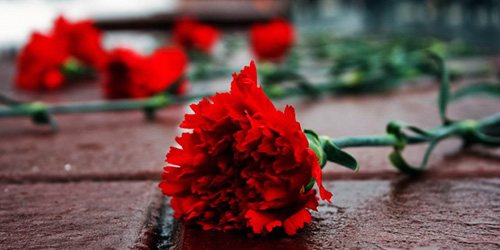

If you have no experience of attending a funeral, the question of where to put the flowers brought can become problematic. Next, we will clarify this subtle point.
If the farewell to the deceased is organized in the traditions of Orthodoxy, a separate place is usually allocated where the brought bouquets are folded.You just have to observe where the rest of those present are taking their flowers and repeat after them.
Live plants are removed from the wrappers and placed near the coffin or on top of it. With the lid open, you can go inside. Usually at the funeral some time is allotted for farewell: during this period, the laying on is performed.
Important: the buds should be directed towards the head of the deceased.
All brought bouquets must move with the coffin to the cemetery, leave them, take them or throw them away.
So, we found out what flowers are appropriate to take with us to the funeral. The traditions of our country imply flowers of discreet shades and in an odd amount. With this simple rule in mind, you can never go wrong with your choice. And if you knew the deceased poorly during his lifetime, buy white roses - an unmistakable neutral option, always appropriate.
Honoring graves with bouquets is a centuries-old ritual that has been passed down from generation to generation. Choosing a flower arrangement becomes a reverent procedure, because the bouquet reflects our feelings and attitude towards the dead. But how do you choose the right flowers for the dead? Are there any rules, unspoken requirements?
When choosing floral ensembles, relatives often have doubts. Moreover, this is true both for bouquets for living people and for ritual obeisances to memory. However, in the latter option, they rarely hesitate over the choice. There are certain taboos on plants for cemetery areas and donation to the living.
Tips for the selection of shades
Not all flowers are suitable for funerals: many of them are too bright or variegated for this mournful ceremony. We will find out which shades in the bouquet will be appropriate.
Red
The shade symbolizes the suffering that the deceased had to endure. Also, a red tone can indicate true love for the deceased or mean a very close relationship.
White
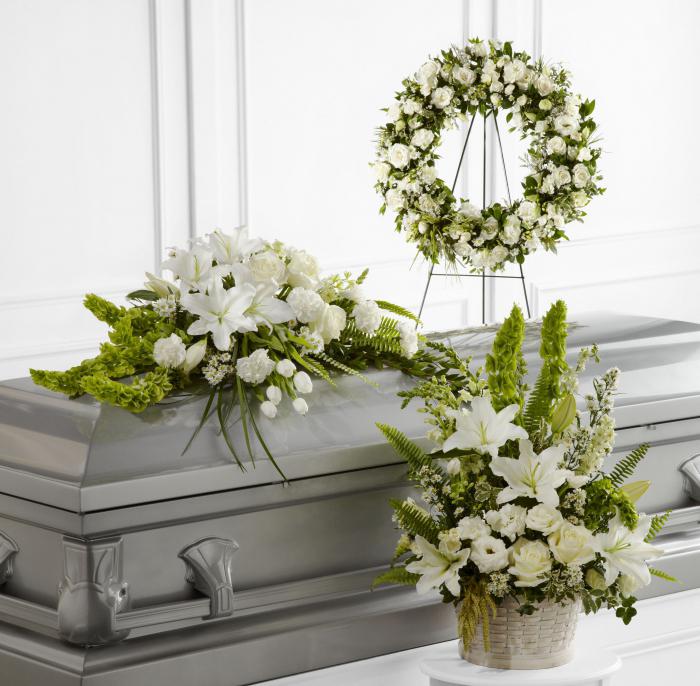

A shade very appropriate for a funeral. Usually white flowers are carried when they want to emphasize the innocence, purity of the body and soul of the deceased. In general, a white shade will help out in any case: it is neutral, and is suitable for both a close relative and a distant acquaintance, a colleague - and of any age.
Yellow and orange
We associate these shades with the wilting of autumn, therefore, it is appropriate to present mourning bouquets of these flowers to an elderly person.
Pink
This shade will be appropriate at the funeral of a young girl, it is also suitable for a woman - home, family. A man is not presented with pink flowers.
Blue
The shade symbolizes sadness and grief, so it will be quite appropriate for the funeral. There are not many blue plants: and if you find them, be sure to buy.
A combination of two to three shades
Although this is not a very common technique when drawing up funeral bouquets, however, in some cases it can be quite appropriate. Usually, a composition of several shades is presented when they want to emphasize admiration for the multifaceted and vibrant nature of the deceased.
Advice: no matter what shade of plant you choose, a black ribbon will help to emphasize the funeral meaning of the bouquet.


